Leadership and Operational Management Approaches at Tesco
VerifiedAdded on 2023/06/05
|12
|4084
|404
Report
AI Summary
This report provides an analysis of leadership and operational management within Tesco, a British supermarket chain. It identifies various roles and characteristics of leaders and managers, exploring how these roles apply in the context of organizational working. The report delves into key approaches to operational management, highlighting the role of leadership in achieving Tesco's business objectives. Furthermore, it examines the forces impacting Tesco's operations management and decision-making processes. Leadership theories such as system theory, situational theory, and contingency theory are discussed in relation to Tesco's practices. The analysis emphasizes the significance of effective planning, organizing, staffing, directing, and controlling functions performed by managers and the importance of setting a clear vision and mission by leaders to drive organizational success. The report concludes by underscoring the critical role of both leadership and operational management in sustaining Tesco's goals and maintaining a competitive edge in the global market.
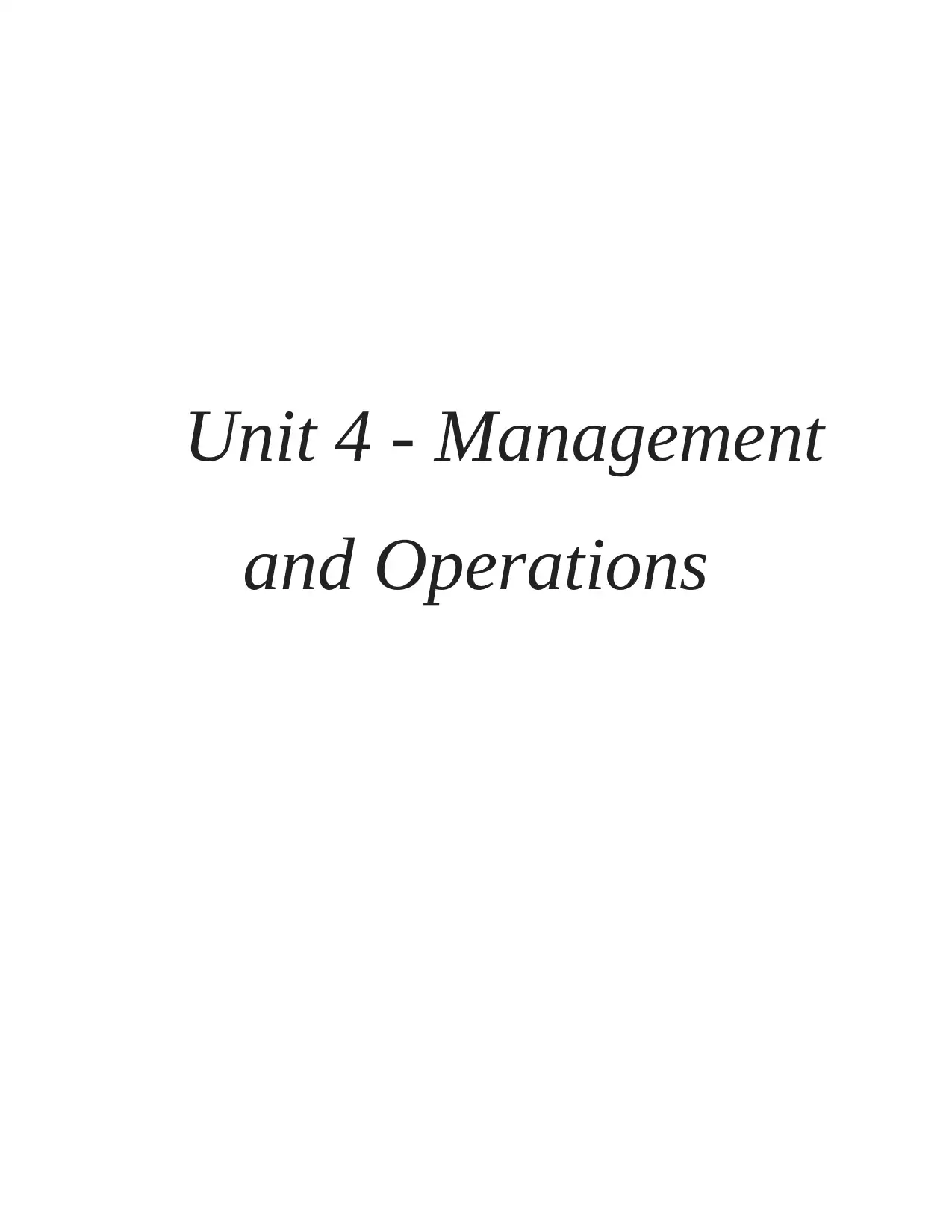
Unit 4 - Management
and Operations
and Operations
Paraphrase This Document
Need a fresh take? Get an instant paraphrase of this document with our AI Paraphraser
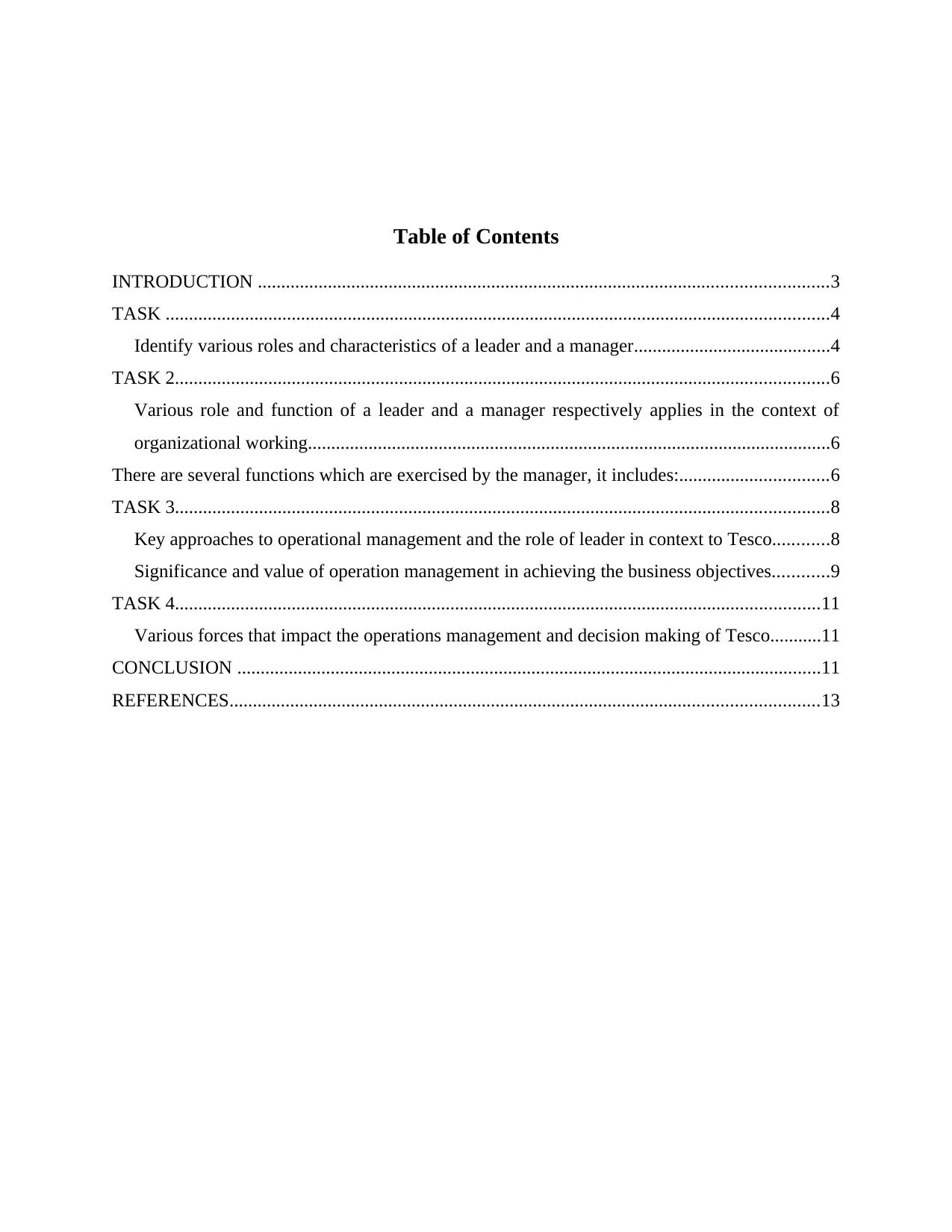
Table of Contents
INTRODUCTION ..........................................................................................................................3
TASK ..............................................................................................................................................4
Identify various roles and characteristics of a leader and a manager..........................................4
TASK 2............................................................................................................................................6
Various role and function of a leader and a manager respectively applies in the context of
organizational working................................................................................................................6
There are several functions which are exercised by the manager, it includes:................................6
TASK 3............................................................................................................................................8
Key approaches to operational management and the role of leader in context to Tesco............8
Significance and value of operation management in achieving the business objectives............9
TASK 4..........................................................................................................................................11
Various forces that impact the operations management and decision making of Tesco...........11
CONCLUSION .............................................................................................................................11
REFERENCES..............................................................................................................................13
INTRODUCTION ..........................................................................................................................3
TASK ..............................................................................................................................................4
Identify various roles and characteristics of a leader and a manager..........................................4
TASK 2............................................................................................................................................6
Various role and function of a leader and a manager respectively applies in the context of
organizational working................................................................................................................6
There are several functions which are exercised by the manager, it includes:................................6
TASK 3............................................................................................................................................8
Key approaches to operational management and the role of leader in context to Tesco............8
Significance and value of operation management in achieving the business objectives............9
TASK 4..........................................................................................................................................11
Various forces that impact the operations management and decision making of Tesco...........11
CONCLUSION .............................................................................................................................11
REFERENCES..............................................................................................................................13
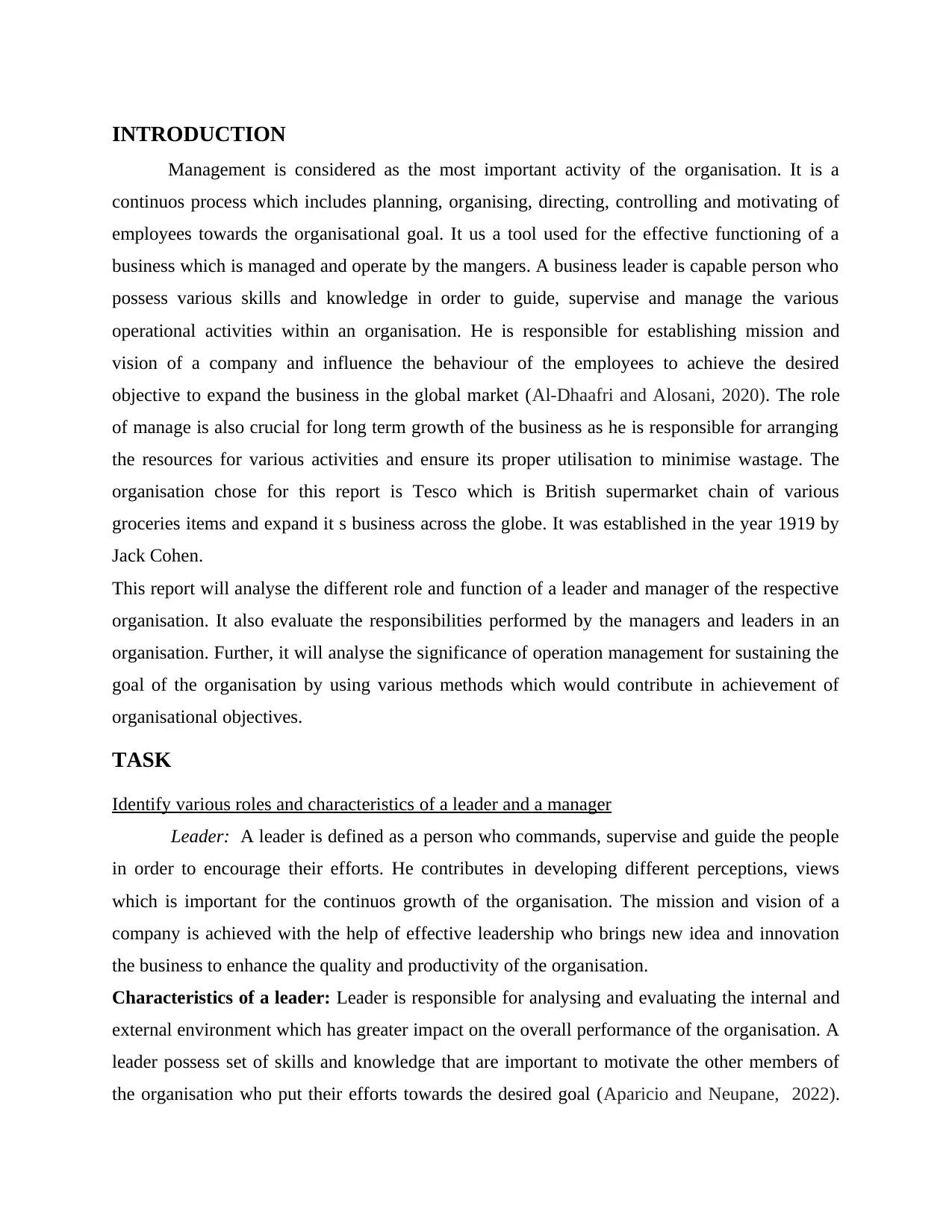
INTRODUCTION
Management is considered as the most important activity of the organisation. It is a
continuos process which includes planning, organising, directing, controlling and motivating of
employees towards the organisational goal. It us a tool used for the effective functioning of a
business which is managed and operate by the mangers. A business leader is capable person who
possess various skills and knowledge in order to guide, supervise and manage the various
operational activities within an organisation. He is responsible for establishing mission and
vision of a company and influence the behaviour of the employees to achieve the desired
objective to expand the business in the global market (Al-Dhaafri and Alosani, 2020). The role
of manage is also crucial for long term growth of the business as he is responsible for arranging
the resources for various activities and ensure its proper utilisation to minimise wastage. The
organisation chose for this report is Tesco which is British supermarket chain of various
groceries items and expand it s business across the globe. It was established in the year 1919 by
Jack Cohen.
This report will analyse the different role and function of a leader and manager of the respective
organisation. It also evaluate the responsibilities performed by the managers and leaders in an
organisation. Further, it will analyse the significance of operation management for sustaining the
goal of the organisation by using various methods which would contribute in achievement of
organisational objectives.
TASK
Identify various roles and characteristics of a leader and a manager
Leader: A leader is defined as a person who commands, supervise and guide the people
in order to encourage their efforts. He contributes in developing different perceptions, views
which is important for the continuos growth of the organisation. The mission and vision of a
company is achieved with the help of effective leadership who brings new idea and innovation
the business to enhance the quality and productivity of the organisation.
Characteristics of a leader: Leader is responsible for analysing and evaluating the internal and
external environment which has greater impact on the overall performance of the organisation. A
leader possess set of skills and knowledge that are important to motivate the other members of
the organisation who put their efforts towards the desired goal (Aparicio and Neupane, 2022).
Management is considered as the most important activity of the organisation. It is a
continuos process which includes planning, organising, directing, controlling and motivating of
employees towards the organisational goal. It us a tool used for the effective functioning of a
business which is managed and operate by the mangers. A business leader is capable person who
possess various skills and knowledge in order to guide, supervise and manage the various
operational activities within an organisation. He is responsible for establishing mission and
vision of a company and influence the behaviour of the employees to achieve the desired
objective to expand the business in the global market (Al-Dhaafri and Alosani, 2020). The role
of manage is also crucial for long term growth of the business as he is responsible for arranging
the resources for various activities and ensure its proper utilisation to minimise wastage. The
organisation chose for this report is Tesco which is British supermarket chain of various
groceries items and expand it s business across the globe. It was established in the year 1919 by
Jack Cohen.
This report will analyse the different role and function of a leader and manager of the respective
organisation. It also evaluate the responsibilities performed by the managers and leaders in an
organisation. Further, it will analyse the significance of operation management for sustaining the
goal of the organisation by using various methods which would contribute in achievement of
organisational objectives.
TASK
Identify various roles and characteristics of a leader and a manager
Leader: A leader is defined as a person who commands, supervise and guide the people
in order to encourage their efforts. He contributes in developing different perceptions, views
which is important for the continuos growth of the organisation. The mission and vision of a
company is achieved with the help of effective leadership who brings new idea and innovation
the business to enhance the quality and productivity of the organisation.
Characteristics of a leader: Leader is responsible for analysing and evaluating the internal and
external environment which has greater impact on the overall performance of the organisation. A
leader possess set of skills and knowledge that are important to motivate the other members of
the organisation who put their efforts towards the desired goal (Aparicio and Neupane, 2022).
⊘ This is a preview!⊘
Do you want full access?
Subscribe today to unlock all pages.

Trusted by 1+ million students worldwide
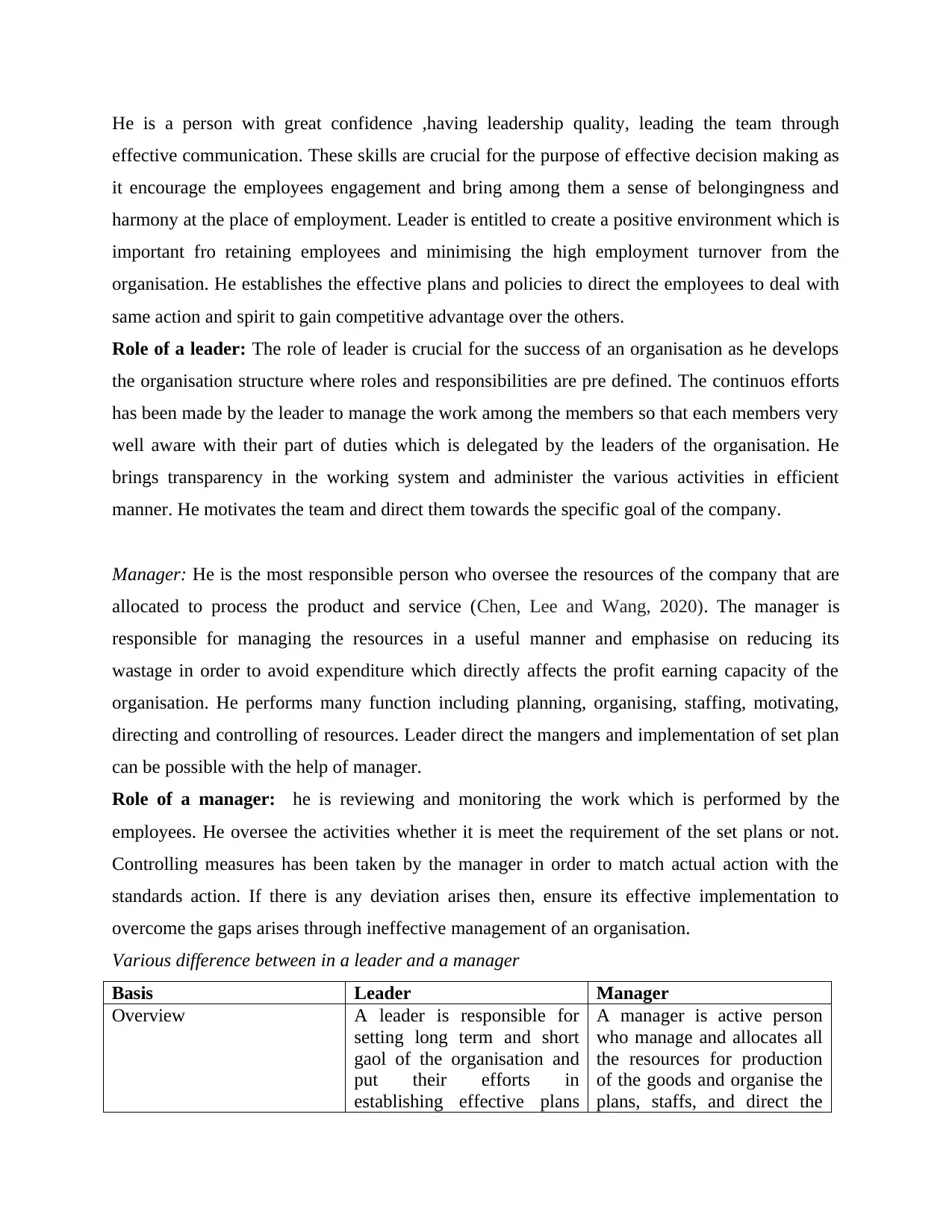
He is a person with great confidence ,having leadership quality, leading the team through
effective communication. These skills are crucial for the purpose of effective decision making as
it encourage the employees engagement and bring among them a sense of belongingness and
harmony at the place of employment. Leader is entitled to create a positive environment which is
important fro retaining employees and minimising the high employment turnover from the
organisation. He establishes the effective plans and policies to direct the employees to deal with
same action and spirit to gain competitive advantage over the others.
Role of a leader: The role of leader is crucial for the success of an organisation as he develops
the organisation structure where roles and responsibilities are pre defined. The continuos efforts
has been made by the leader to manage the work among the members so that each members very
well aware with their part of duties which is delegated by the leaders of the organisation. He
brings transparency in the working system and administer the various activities in efficient
manner. He motivates the team and direct them towards the specific goal of the company.
Manager: He is the most responsible person who oversee the resources of the company that are
allocated to process the product and service (Chen, Lee and Wang, 2020). The manager is
responsible for managing the resources in a useful manner and emphasise on reducing its
wastage in order to avoid expenditure which directly affects the profit earning capacity of the
organisation. He performs many function including planning, organising, staffing, motivating,
directing and controlling of resources. Leader direct the mangers and implementation of set plan
can be possible with the help of manager.
Role of a manager: he is reviewing and monitoring the work which is performed by the
employees. He oversee the activities whether it is meet the requirement of the set plans or not.
Controlling measures has been taken by the manager in order to match actual action with the
standards action. If there is any deviation arises then, ensure its effective implementation to
overcome the gaps arises through ineffective management of an organisation.
Various difference between in a leader and a manager
Basis Leader Manager
Overview A leader is responsible for
setting long term and short
gaol of the organisation and
put their efforts in
establishing effective plans
A manager is active person
who manage and allocates all
the resources for production
of the goods and organise the
plans, staffs, and direct the
effective communication. These skills are crucial for the purpose of effective decision making as
it encourage the employees engagement and bring among them a sense of belongingness and
harmony at the place of employment. Leader is entitled to create a positive environment which is
important fro retaining employees and minimising the high employment turnover from the
organisation. He establishes the effective plans and policies to direct the employees to deal with
same action and spirit to gain competitive advantage over the others.
Role of a leader: The role of leader is crucial for the success of an organisation as he develops
the organisation structure where roles and responsibilities are pre defined. The continuos efforts
has been made by the leader to manage the work among the members so that each members very
well aware with their part of duties which is delegated by the leaders of the organisation. He
brings transparency in the working system and administer the various activities in efficient
manner. He motivates the team and direct them towards the specific goal of the company.
Manager: He is the most responsible person who oversee the resources of the company that are
allocated to process the product and service (Chen, Lee and Wang, 2020). The manager is
responsible for managing the resources in a useful manner and emphasise on reducing its
wastage in order to avoid expenditure which directly affects the profit earning capacity of the
organisation. He performs many function including planning, organising, staffing, motivating,
directing and controlling of resources. Leader direct the mangers and implementation of set plan
can be possible with the help of manager.
Role of a manager: he is reviewing and monitoring the work which is performed by the
employees. He oversee the activities whether it is meet the requirement of the set plans or not.
Controlling measures has been taken by the manager in order to match actual action with the
standards action. If there is any deviation arises then, ensure its effective implementation to
overcome the gaps arises through ineffective management of an organisation.
Various difference between in a leader and a manager
Basis Leader Manager
Overview A leader is responsible for
setting long term and short
gaol of the organisation and
put their efforts in
establishing effective plans
A manager is active person
who manage and allocates all
the resources for production
of the goods and organise the
plans, staffs, and direct the
Paraphrase This Document
Need a fresh take? Get an instant paraphrase of this document with our AI Paraphraser
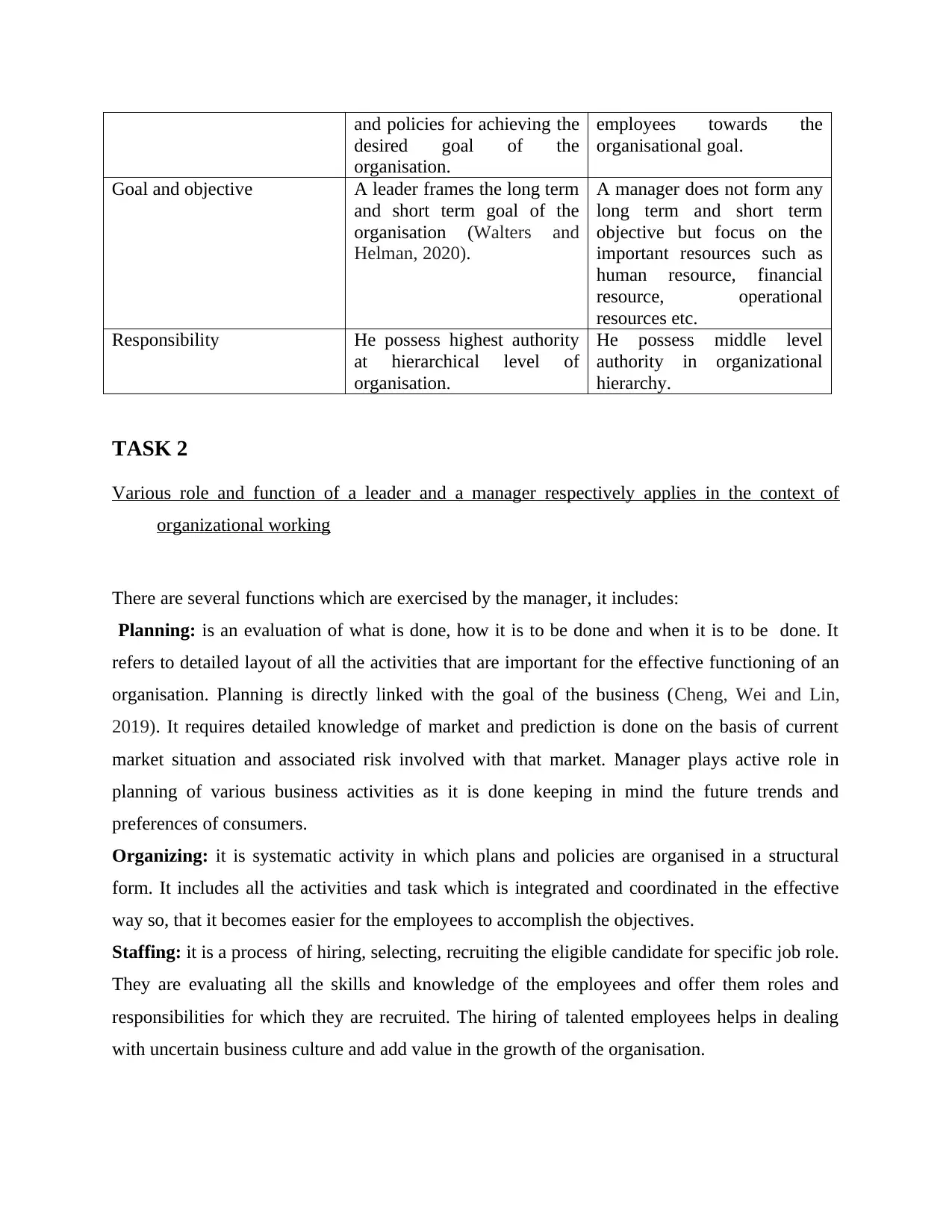
and policies for achieving the
desired goal of the
organisation.
employees towards the
organisational goal.
Goal and objective A leader frames the long term
and short term goal of the
organisation (Walters and
Helman, 2020).
A manager does not form any
long term and short term
objective but focus on the
important resources such as
human resource, financial
resource, operational
resources etc.
Responsibility He possess highest authority
at hierarchical level of
organisation.
He possess middle level
authority in organizational
hierarchy.
TASK 2
Various role and function of a leader and a manager respectively applies in the context of
organizational working
There are several functions which are exercised by the manager, it includes:
Planning: is an evaluation of what is done, how it is to be done and when it is to be done. It
refers to detailed layout of all the activities that are important for the effective functioning of an
organisation. Planning is directly linked with the goal of the business (Cheng, Wei and Lin,
2019). It requires detailed knowledge of market and prediction is done on the basis of current
market situation and associated risk involved with that market. Manager plays active role in
planning of various business activities as it is done keeping in mind the future trends and
preferences of consumers.
Organizing: it is systematic activity in which plans and policies are organised in a structural
form. It includes all the activities and task which is integrated and coordinated in the effective
way so, that it becomes easier for the employees to accomplish the objectives.
Staffing: it is a process of hiring, selecting, recruiting the eligible candidate for specific job role.
They are evaluating all the skills and knowledge of the employees and offer them roles and
responsibilities for which they are recruited. The hiring of talented employees helps in dealing
with uncertain business culture and add value in the growth of the organisation.
desired goal of the
organisation.
employees towards the
organisational goal.
Goal and objective A leader frames the long term
and short term goal of the
organisation (Walters and
Helman, 2020).
A manager does not form any
long term and short term
objective but focus on the
important resources such as
human resource, financial
resource, operational
resources etc.
Responsibility He possess highest authority
at hierarchical level of
organisation.
He possess middle level
authority in organizational
hierarchy.
TASK 2
Various role and function of a leader and a manager respectively applies in the context of
organizational working
There are several functions which are exercised by the manager, it includes:
Planning: is an evaluation of what is done, how it is to be done and when it is to be done. It
refers to detailed layout of all the activities that are important for the effective functioning of an
organisation. Planning is directly linked with the goal of the business (Cheng, Wei and Lin,
2019). It requires detailed knowledge of market and prediction is done on the basis of current
market situation and associated risk involved with that market. Manager plays active role in
planning of various business activities as it is done keeping in mind the future trends and
preferences of consumers.
Organizing: it is systematic activity in which plans and policies are organised in a structural
form. It includes all the activities and task which is integrated and coordinated in the effective
way so, that it becomes easier for the employees to accomplish the objectives.
Staffing: it is a process of hiring, selecting, recruiting the eligible candidate for specific job role.
They are evaluating all the skills and knowledge of the employees and offer them roles and
responsibilities for which they are recruited. The hiring of talented employees helps in dealing
with uncertain business culture and add value in the growth of the organisation.
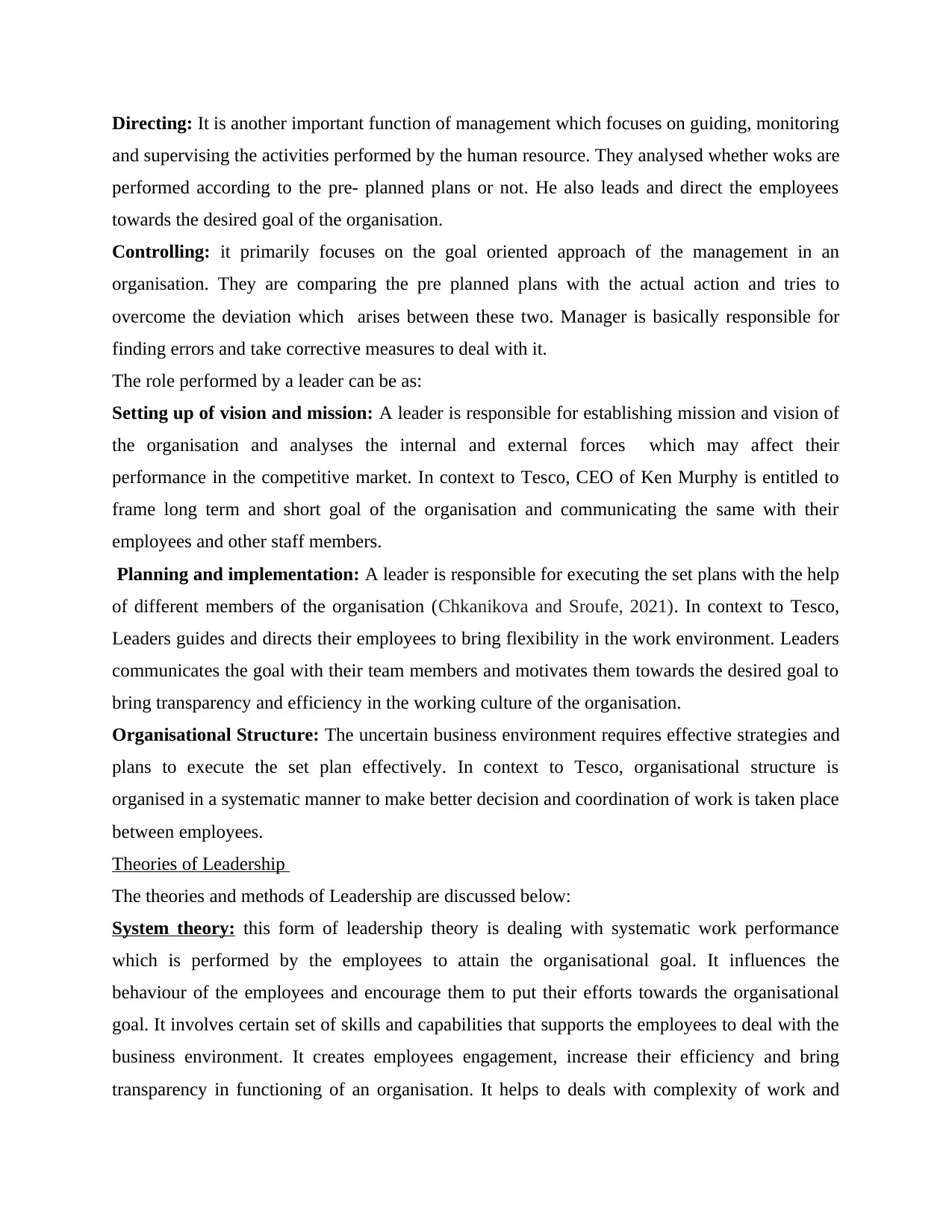
Directing: It is another important function of management which focuses on guiding, monitoring
and supervising the activities performed by the human resource. They analysed whether woks are
performed according to the pre- planned plans or not. He also leads and direct the employees
towards the desired goal of the organisation.
Controlling: it primarily focuses on the goal oriented approach of the management in an
organisation. They are comparing the pre planned plans with the actual action and tries to
overcome the deviation which arises between these two. Manager is basically responsible for
finding errors and take corrective measures to deal with it.
The role performed by a leader can be as:
Setting up of vision and mission: A leader is responsible for establishing mission and vision of
the organisation and analyses the internal and external forces which may affect their
performance in the competitive market. In context to Tesco, CEO of Ken Murphy is entitled to
frame long term and short goal of the organisation and communicating the same with their
employees and other staff members.
Planning and implementation: A leader is responsible for executing the set plans with the help
of different members of the organisation (Chkanikova and Sroufe, 2021). In context to Tesco,
Leaders guides and directs their employees to bring flexibility in the work environment. Leaders
communicates the goal with their team members and motivates them towards the desired goal to
bring transparency and efficiency in the working culture of the organisation.
Organisational Structure: The uncertain business environment requires effective strategies and
plans to execute the set plan effectively. In context to Tesco, organisational structure is
organised in a systematic manner to make better decision and coordination of work is taken place
between employees.
Theories of Leadership
The theories and methods of Leadership are discussed below:
System theory: this form of leadership theory is dealing with systematic work performance
which is performed by the employees to attain the organisational goal. It influences the
behaviour of the employees and encourage them to put their efforts towards the organisational
goal. It involves certain set of skills and capabilities that supports the employees to deal with the
business environment. It creates employees engagement, increase their efficiency and bring
transparency in functioning of an organisation. It helps to deals with complexity of work and
and supervising the activities performed by the human resource. They analysed whether woks are
performed according to the pre- planned plans or not. He also leads and direct the employees
towards the desired goal of the organisation.
Controlling: it primarily focuses on the goal oriented approach of the management in an
organisation. They are comparing the pre planned plans with the actual action and tries to
overcome the deviation which arises between these two. Manager is basically responsible for
finding errors and take corrective measures to deal with it.
The role performed by a leader can be as:
Setting up of vision and mission: A leader is responsible for establishing mission and vision of
the organisation and analyses the internal and external forces which may affect their
performance in the competitive market. In context to Tesco, CEO of Ken Murphy is entitled to
frame long term and short goal of the organisation and communicating the same with their
employees and other staff members.
Planning and implementation: A leader is responsible for executing the set plans with the help
of different members of the organisation (Chkanikova and Sroufe, 2021). In context to Tesco,
Leaders guides and directs their employees to bring flexibility in the work environment. Leaders
communicates the goal with their team members and motivates them towards the desired goal to
bring transparency and efficiency in the working culture of the organisation.
Organisational Structure: The uncertain business environment requires effective strategies and
plans to execute the set plan effectively. In context to Tesco, organisational structure is
organised in a systematic manner to make better decision and coordination of work is taken place
between employees.
Theories of Leadership
The theories and methods of Leadership are discussed below:
System theory: this form of leadership theory is dealing with systematic work performance
which is performed by the employees to attain the organisational goal. It influences the
behaviour of the employees and encourage them to put their efforts towards the organisational
goal. It involves certain set of skills and capabilities that supports the employees to deal with the
business environment. It creates employees engagement, increase their efficiency and bring
transparency in functioning of an organisation. It helps to deals with complexity of work and
⊘ This is a preview!⊘
Do you want full access?
Subscribe today to unlock all pages.

Trusted by 1+ million students worldwide
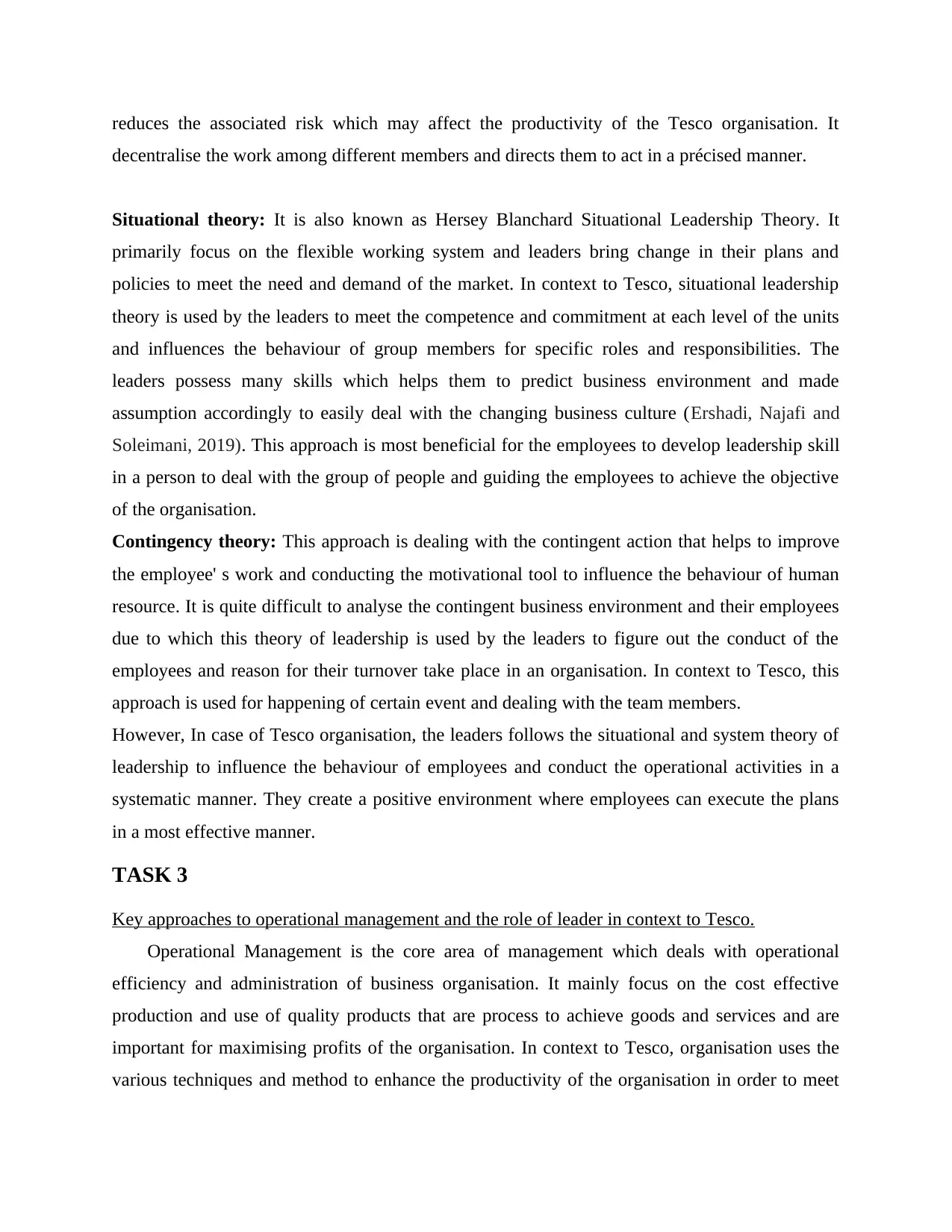
reduces the associated risk which may affect the productivity of the Tesco organisation. It
decentralise the work among different members and directs them to act in a précised manner.
Situational theory: It is also known as Hersey Blanchard Situational Leadership Theory. It
primarily focus on the flexible working system and leaders bring change in their plans and
policies to meet the need and demand of the market. In context to Tesco, situational leadership
theory is used by the leaders to meet the competence and commitment at each level of the units
and influences the behaviour of group members for specific roles and responsibilities. The
leaders possess many skills which helps them to predict business environment and made
assumption accordingly to easily deal with the changing business culture (Ershadi, Najafi and
Soleimani, 2019). This approach is most beneficial for the employees to develop leadership skill
in a person to deal with the group of people and guiding the employees to achieve the objective
of the organisation.
Contingency theory: This approach is dealing with the contingent action that helps to improve
the employee' s work and conducting the motivational tool to influence the behaviour of human
resource. It is quite difficult to analyse the contingent business environment and their employees
due to which this theory of leadership is used by the leaders to figure out the conduct of the
employees and reason for their turnover take place in an organisation. In context to Tesco, this
approach is used for happening of certain event and dealing with the team members.
However, In case of Tesco organisation, the leaders follows the situational and system theory of
leadership to influence the behaviour of employees and conduct the operational activities in a
systematic manner. They create a positive environment where employees can execute the plans
in a most effective manner.
TASK 3
Key approaches to operational management and the role of leader in context to Tesco.
Operational Management is the core area of management which deals with operational
efficiency and administration of business organisation. It mainly focus on the cost effective
production and use of quality products that are process to achieve goods and services and are
important for maximising profits of the organisation. In context to Tesco, organisation uses the
various techniques and method to enhance the productivity of the organisation in order to meet
decentralise the work among different members and directs them to act in a précised manner.
Situational theory: It is also known as Hersey Blanchard Situational Leadership Theory. It
primarily focus on the flexible working system and leaders bring change in their plans and
policies to meet the need and demand of the market. In context to Tesco, situational leadership
theory is used by the leaders to meet the competence and commitment at each level of the units
and influences the behaviour of group members for specific roles and responsibilities. The
leaders possess many skills which helps them to predict business environment and made
assumption accordingly to easily deal with the changing business culture (Ershadi, Najafi and
Soleimani, 2019). This approach is most beneficial for the employees to develop leadership skill
in a person to deal with the group of people and guiding the employees to achieve the objective
of the organisation.
Contingency theory: This approach is dealing with the contingent action that helps to improve
the employee' s work and conducting the motivational tool to influence the behaviour of human
resource. It is quite difficult to analyse the contingent business environment and their employees
due to which this theory of leadership is used by the leaders to figure out the conduct of the
employees and reason for their turnover take place in an organisation. In context to Tesco, this
approach is used for happening of certain event and dealing with the team members.
However, In case of Tesco organisation, the leaders follows the situational and system theory of
leadership to influence the behaviour of employees and conduct the operational activities in a
systematic manner. They create a positive environment where employees can execute the plans
in a most effective manner.
TASK 3
Key approaches to operational management and the role of leader in context to Tesco.
Operational Management is the core area of management which deals with operational
efficiency and administration of business organisation. It mainly focus on the cost effective
production and use of quality products that are process to achieve goods and services and are
important for maximising profits of the organisation. In context to Tesco, organisation uses the
various techniques and method to enhance the productivity of the organisation in order to meet
Paraphrase This Document
Need a fresh take? Get an instant paraphrase of this document with our AI Paraphraser
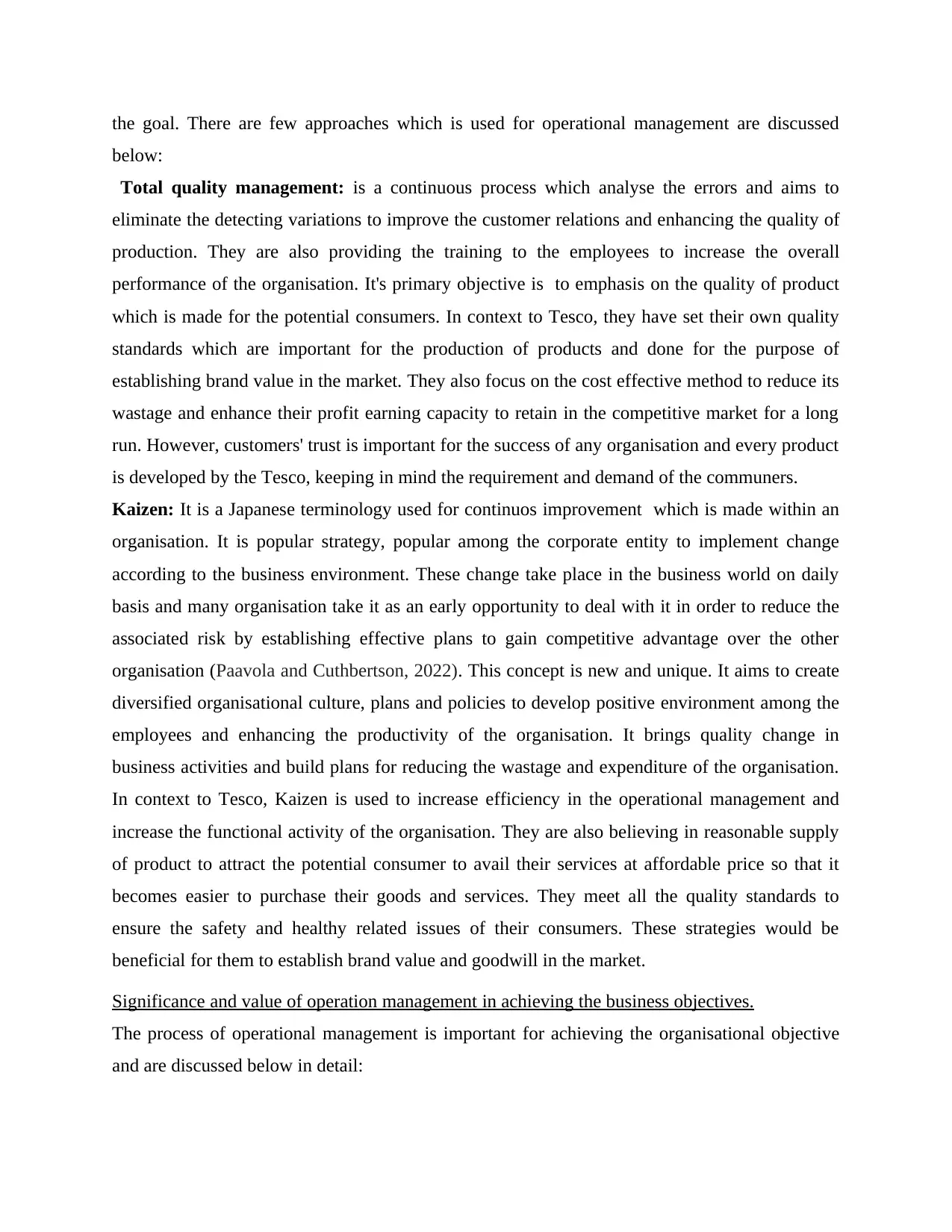
the goal. There are few approaches which is used for operational management are discussed
below:
Total quality management: is a continuous process which analyse the errors and aims to
eliminate the detecting variations to improve the customer relations and enhancing the quality of
production. They are also providing the training to the employees to increase the overall
performance of the organisation. It's primary objective is to emphasis on the quality of product
which is made for the potential consumers. In context to Tesco, they have set their own quality
standards which are important for the production of products and done for the purpose of
establishing brand value in the market. They also focus on the cost effective method to reduce its
wastage and enhance their profit earning capacity to retain in the competitive market for a long
run. However, customers' trust is important for the success of any organisation and every product
is developed by the Tesco, keeping in mind the requirement and demand of the communers.
Kaizen: It is a Japanese terminology used for continuos improvement which is made within an
organisation. It is popular strategy, popular among the corporate entity to implement change
according to the business environment. These change take place in the business world on daily
basis and many organisation take it as an early opportunity to deal with it in order to reduce the
associated risk by establishing effective plans to gain competitive advantage over the other
organisation (Paavola and Cuthbertson, 2022). This concept is new and unique. It aims to create
diversified organisational culture, plans and policies to develop positive environment among the
employees and enhancing the productivity of the organisation. It brings quality change in
business activities and build plans for reducing the wastage and expenditure of the organisation.
In context to Tesco, Kaizen is used to increase efficiency in the operational management and
increase the functional activity of the organisation. They are also believing in reasonable supply
of product to attract the potential consumer to avail their services at affordable price so that it
becomes easier to purchase their goods and services. They meet all the quality standards to
ensure the safety and healthy related issues of their consumers. These strategies would be
beneficial for them to establish brand value and goodwill in the market.
Significance and value of operation management in achieving the business objectives.
The process of operational management is important for achieving the organisational objective
and are discussed below in detail:
below:
Total quality management: is a continuous process which analyse the errors and aims to
eliminate the detecting variations to improve the customer relations and enhancing the quality of
production. They are also providing the training to the employees to increase the overall
performance of the organisation. It's primary objective is to emphasis on the quality of product
which is made for the potential consumers. In context to Tesco, they have set their own quality
standards which are important for the production of products and done for the purpose of
establishing brand value in the market. They also focus on the cost effective method to reduce its
wastage and enhance their profit earning capacity to retain in the competitive market for a long
run. However, customers' trust is important for the success of any organisation and every product
is developed by the Tesco, keeping in mind the requirement and demand of the communers.
Kaizen: It is a Japanese terminology used for continuos improvement which is made within an
organisation. It is popular strategy, popular among the corporate entity to implement change
according to the business environment. These change take place in the business world on daily
basis and many organisation take it as an early opportunity to deal with it in order to reduce the
associated risk by establishing effective plans to gain competitive advantage over the other
organisation (Paavola and Cuthbertson, 2022). This concept is new and unique. It aims to create
diversified organisational culture, plans and policies to develop positive environment among the
employees and enhancing the productivity of the organisation. It brings quality change in
business activities and build plans for reducing the wastage and expenditure of the organisation.
In context to Tesco, Kaizen is used to increase efficiency in the operational management and
increase the functional activity of the organisation. They are also believing in reasonable supply
of product to attract the potential consumer to avail their services at affordable price so that it
becomes easier to purchase their goods and services. They meet all the quality standards to
ensure the safety and healthy related issues of their consumers. These strategies would be
beneficial for them to establish brand value and goodwill in the market.
Significance and value of operation management in achieving the business objectives.
The process of operational management is important for achieving the organisational objective
and are discussed below in detail:
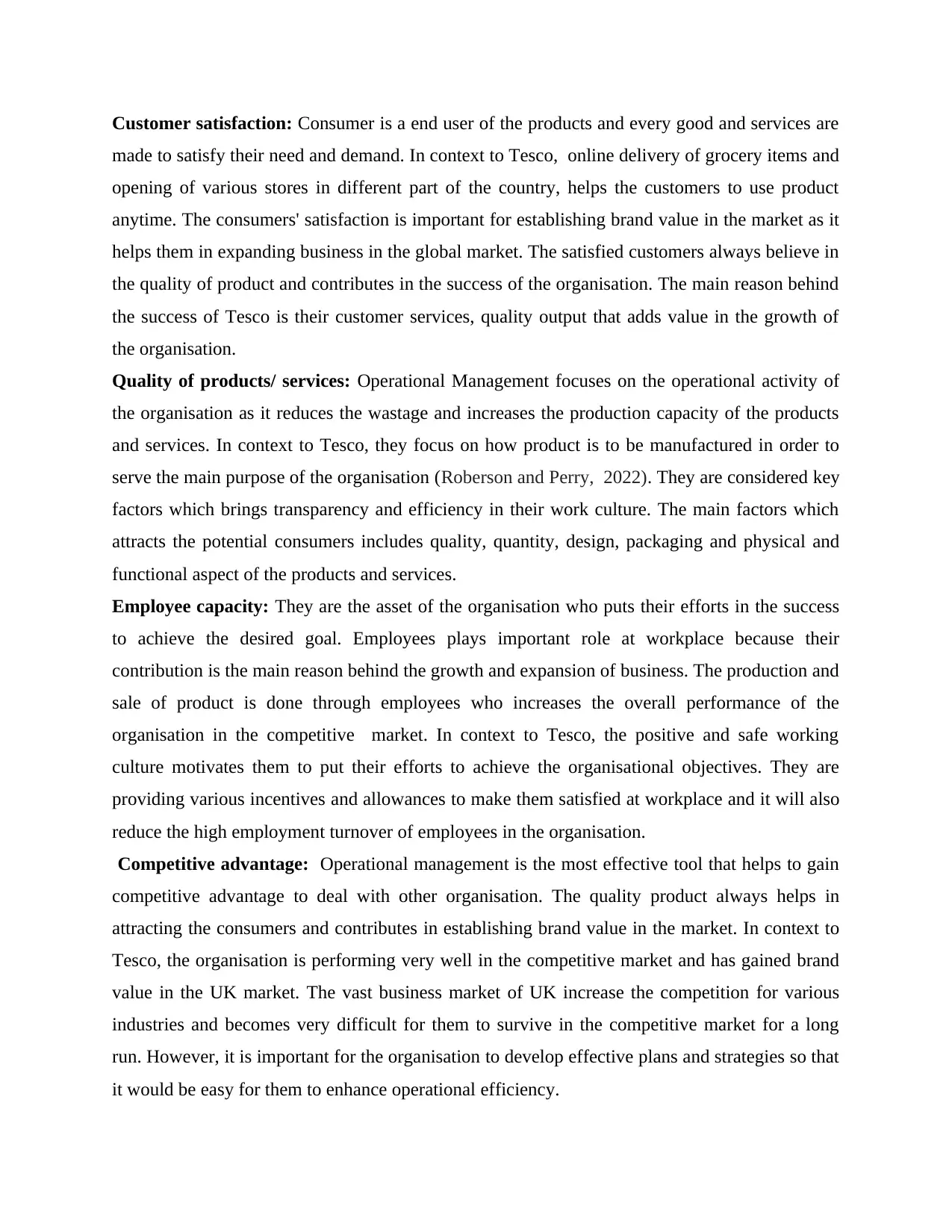
Customer satisfaction: Consumer is a end user of the products and every good and services are
made to satisfy their need and demand. In context to Tesco, online delivery of grocery items and
opening of various stores in different part of the country, helps the customers to use product
anytime. The consumers' satisfaction is important for establishing brand value in the market as it
helps them in expanding business in the global market. The satisfied customers always believe in
the quality of product and contributes in the success of the organisation. The main reason behind
the success of Tesco is their customer services, quality output that adds value in the growth of
the organisation.
Quality of products/ services: Operational Management focuses on the operational activity of
the organisation as it reduces the wastage and increases the production capacity of the products
and services. In context to Tesco, they focus on how product is to be manufactured in order to
serve the main purpose of the organisation (Roberson and Perry, 2022). They are considered key
factors which brings transparency and efficiency in their work culture. The main factors which
attracts the potential consumers includes quality, quantity, design, packaging and physical and
functional aspect of the products and services.
Employee capacity: They are the asset of the organisation who puts their efforts in the success
to achieve the desired goal. Employees plays important role at workplace because their
contribution is the main reason behind the growth and expansion of business. The production and
sale of product is done through employees who increases the overall performance of the
organisation in the competitive market. In context to Tesco, the positive and safe working
culture motivates them to put their efforts to achieve the organisational objectives. They are
providing various incentives and allowances to make them satisfied at workplace and it will also
reduce the high employment turnover of employees in the organisation.
Competitive advantage: Operational management is the most effective tool that helps to gain
competitive advantage to deal with other organisation. The quality product always helps in
attracting the consumers and contributes in establishing brand value in the market. In context to
Tesco, the organisation is performing very well in the competitive market and has gained brand
value in the UK market. The vast business market of UK increase the competition for various
industries and becomes very difficult for them to survive in the competitive market for a long
run. However, it is important for the organisation to develop effective plans and strategies so that
it would be easy for them to enhance operational efficiency.
made to satisfy their need and demand. In context to Tesco, online delivery of grocery items and
opening of various stores in different part of the country, helps the customers to use product
anytime. The consumers' satisfaction is important for establishing brand value in the market as it
helps them in expanding business in the global market. The satisfied customers always believe in
the quality of product and contributes in the success of the organisation. The main reason behind
the success of Tesco is their customer services, quality output that adds value in the growth of
the organisation.
Quality of products/ services: Operational Management focuses on the operational activity of
the organisation as it reduces the wastage and increases the production capacity of the products
and services. In context to Tesco, they focus on how product is to be manufactured in order to
serve the main purpose of the organisation (Roberson and Perry, 2022). They are considered key
factors which brings transparency and efficiency in their work culture. The main factors which
attracts the potential consumers includes quality, quantity, design, packaging and physical and
functional aspect of the products and services.
Employee capacity: They are the asset of the organisation who puts their efforts in the success
to achieve the desired goal. Employees plays important role at workplace because their
contribution is the main reason behind the growth and expansion of business. The production and
sale of product is done through employees who increases the overall performance of the
organisation in the competitive market. In context to Tesco, the positive and safe working
culture motivates them to put their efforts to achieve the organisational objectives. They are
providing various incentives and allowances to make them satisfied at workplace and it will also
reduce the high employment turnover of employees in the organisation.
Competitive advantage: Operational management is the most effective tool that helps to gain
competitive advantage to deal with other organisation. The quality product always helps in
attracting the consumers and contributes in establishing brand value in the market. In context to
Tesco, the organisation is performing very well in the competitive market and has gained brand
value in the UK market. The vast business market of UK increase the competition for various
industries and becomes very difficult for them to survive in the competitive market for a long
run. However, it is important for the organisation to develop effective plans and strategies so that
it would be easy for them to enhance operational efficiency.
⊘ This is a preview!⊘
Do you want full access?
Subscribe today to unlock all pages.

Trusted by 1+ million students worldwide
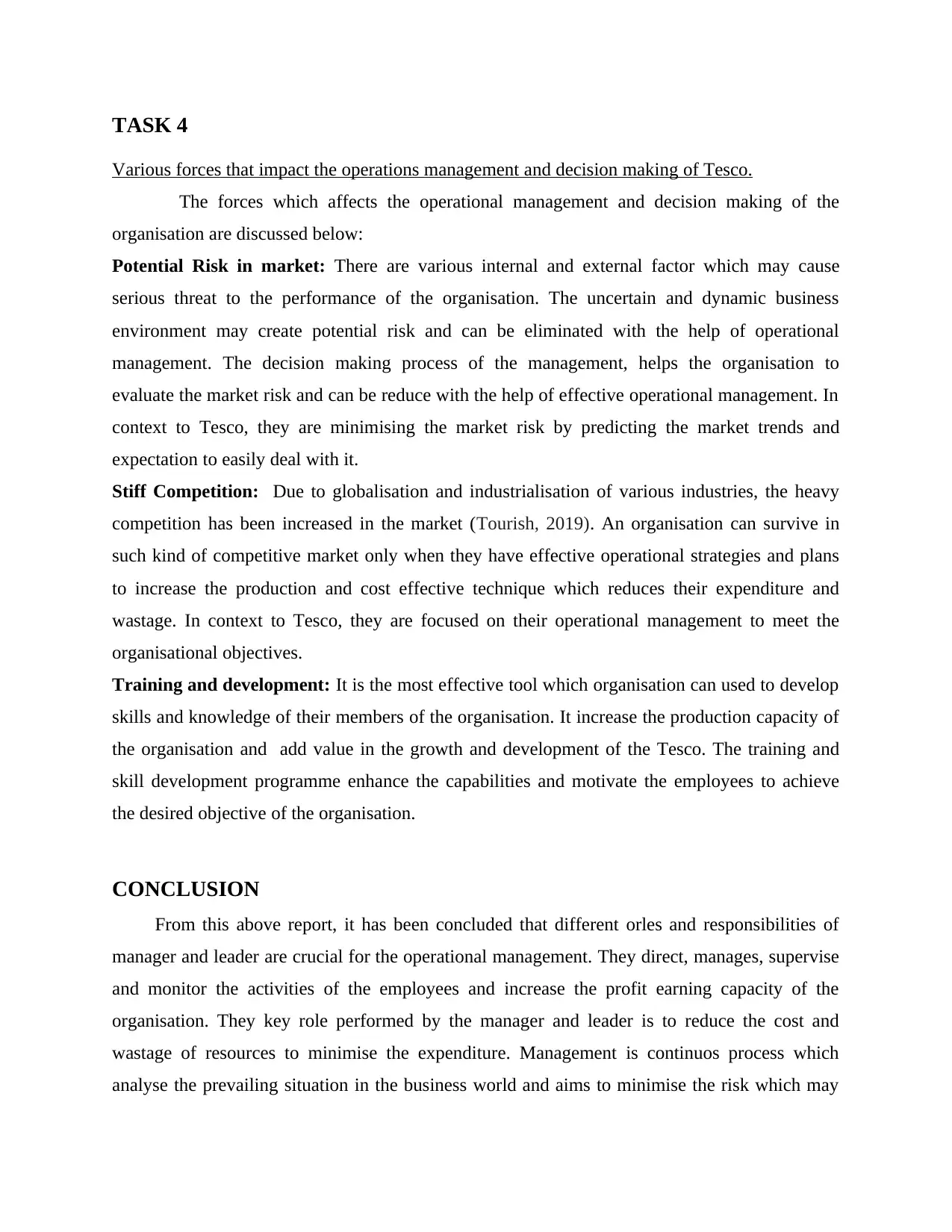
TASK 4
Various forces that impact the operations management and decision making of Tesco.
The forces which affects the operational management and decision making of the
organisation are discussed below:
Potential Risk in market: There are various internal and external factor which may cause
serious threat to the performance of the organisation. The uncertain and dynamic business
environment may create potential risk and can be eliminated with the help of operational
management. The decision making process of the management, helps the organisation to
evaluate the market risk and can be reduce with the help of effective operational management. In
context to Tesco, they are minimising the market risk by predicting the market trends and
expectation to easily deal with it.
Stiff Competition: Due to globalisation and industrialisation of various industries, the heavy
competition has been increased in the market (Tourish, 2019). An organisation can survive in
such kind of competitive market only when they have effective operational strategies and plans
to increase the production and cost effective technique which reduces their expenditure and
wastage. In context to Tesco, they are focused on their operational management to meet the
organisational objectives.
Training and development: It is the most effective tool which organisation can used to develop
skills and knowledge of their members of the organisation. It increase the production capacity of
the organisation and add value in the growth and development of the Tesco. The training and
skill development programme enhance the capabilities and motivate the employees to achieve
the desired objective of the organisation.
CONCLUSION
From this above report, it has been concluded that different orles and responsibilities of
manager and leader are crucial for the operational management. They direct, manages, supervise
and monitor the activities of the employees and increase the profit earning capacity of the
organisation. They key role performed by the manager and leader is to reduce the cost and
wastage of resources to minimise the expenditure. Management is continuos process which
analyse the prevailing situation in the business world and aims to minimise the risk which may
Various forces that impact the operations management and decision making of Tesco.
The forces which affects the operational management and decision making of the
organisation are discussed below:
Potential Risk in market: There are various internal and external factor which may cause
serious threat to the performance of the organisation. The uncertain and dynamic business
environment may create potential risk and can be eliminated with the help of operational
management. The decision making process of the management, helps the organisation to
evaluate the market risk and can be reduce with the help of effective operational management. In
context to Tesco, they are minimising the market risk by predicting the market trends and
expectation to easily deal with it.
Stiff Competition: Due to globalisation and industrialisation of various industries, the heavy
competition has been increased in the market (Tourish, 2019). An organisation can survive in
such kind of competitive market only when they have effective operational strategies and plans
to increase the production and cost effective technique which reduces their expenditure and
wastage. In context to Tesco, they are focused on their operational management to meet the
organisational objectives.
Training and development: It is the most effective tool which organisation can used to develop
skills and knowledge of their members of the organisation. It increase the production capacity of
the organisation and add value in the growth and development of the Tesco. The training and
skill development programme enhance the capabilities and motivate the employees to achieve
the desired objective of the organisation.
CONCLUSION
From this above report, it has been concluded that different orles and responsibilities of
manager and leader are crucial for the operational management. They direct, manages, supervise
and monitor the activities of the employees and increase the profit earning capacity of the
organisation. They key role performed by the manager and leader is to reduce the cost and
wastage of resources to minimise the expenditure. Management is continuos process which
analyse the prevailing situation in the business world and aims to minimise the risk which may
Paraphrase This Document
Need a fresh take? Get an instant paraphrase of this document with our AI Paraphraser
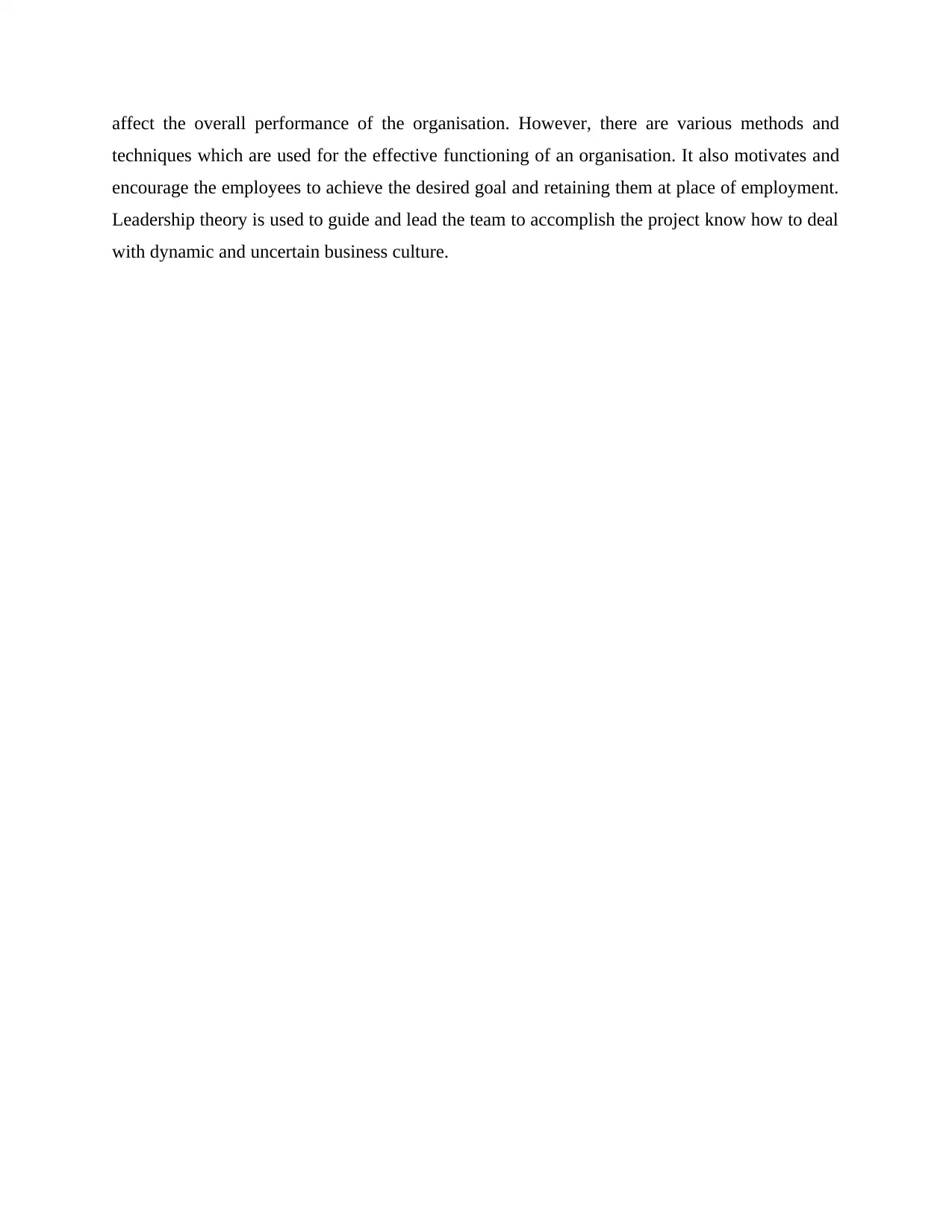
affect the overall performance of the organisation. However, there are various methods and
techniques which are used for the effective functioning of an organisation. It also motivates and
encourage the employees to achieve the desired goal and retaining them at place of employment.
Leadership theory is used to guide and lead the team to accomplish the project know how to deal
with dynamic and uncertain business culture.
techniques which are used for the effective functioning of an organisation. It also motivates and
encourage the employees to achieve the desired goal and retaining them at place of employment.
Leadership theory is used to guide and lead the team to accomplish the project know how to deal
with dynamic and uncertain business culture.
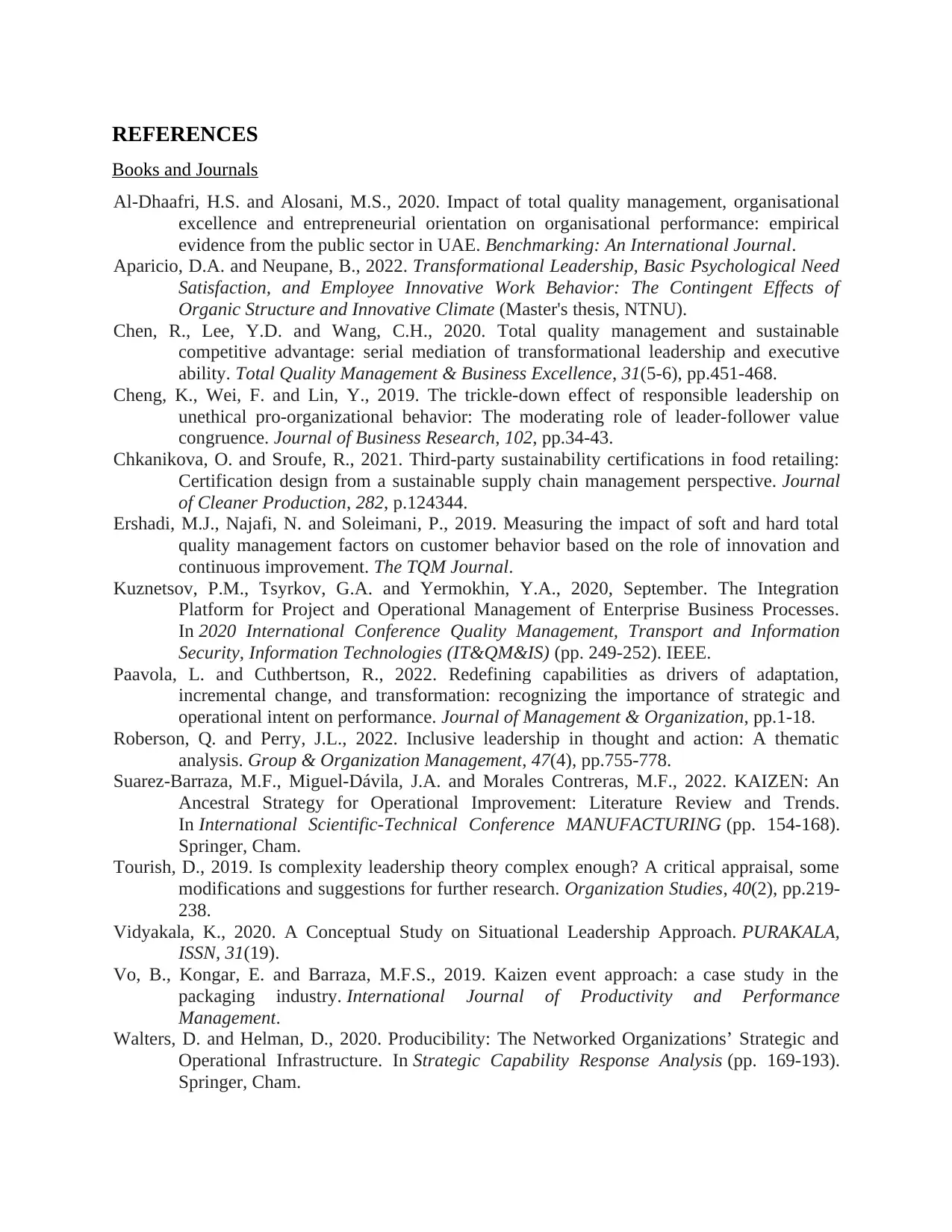
REFERENCES
Books and Journals
Al-Dhaafri, H.S. and Alosani, M.S., 2020. Impact of total quality management, organisational
excellence and entrepreneurial orientation on organisational performance: empirical
evidence from the public sector in UAE. Benchmarking: An International Journal.
Aparicio, D.A. and Neupane, B., 2022. Transformational Leadership, Basic Psychological Need
Satisfaction, and Employee Innovative Work Behavior: The Contingent Effects of
Organic Structure and Innovative Climate (Master's thesis, NTNU).
Chen, R., Lee, Y.D. and Wang, C.H., 2020. Total quality management and sustainable
competitive advantage: serial mediation of transformational leadership and executive
ability. Total Quality Management & Business Excellence, 31(5-6), pp.451-468.
Cheng, K., Wei, F. and Lin, Y., 2019. The trickle-down effect of responsible leadership on
unethical pro-organizational behavior: The moderating role of leader-follower value
congruence. Journal of Business Research, 102, pp.34-43.
Chkanikova, O. and Sroufe, R., 2021. Third-party sustainability certifications in food retailing:
Certification design from a sustainable supply chain management perspective. Journal
of Cleaner Production, 282, p.124344.
Ershadi, M.J., Najafi, N. and Soleimani, P., 2019. Measuring the impact of soft and hard total
quality management factors on customer behavior based on the role of innovation and
continuous improvement. The TQM Journal.
Kuznetsov, P.M., Tsyrkov, G.A. and Yermokhin, Y.A., 2020, September. The Integration
Platform for Project and Operational Management of Enterprise Business Processes.
In 2020 International Conference Quality Management, Transport and Information
Security, Information Technologies (IT&QM&IS) (pp. 249-252). IEEE.
Paavola, L. and Cuthbertson, R., 2022. Redefining capabilities as drivers of adaptation,
incremental change, and transformation: recognizing the importance of strategic and
operational intent on performance. Journal of Management & Organization, pp.1-18.
Roberson, Q. and Perry, J.L., 2022. Inclusive leadership in thought and action: A thematic
analysis. Group & Organization Management, 47(4), pp.755-778.
Suarez-Barraza, M.F., Miguel-Dávila, J.A. and Morales Contreras, M.F., 2022. KAIZEN: An
Ancestral Strategy for Operational Improvement: Literature Review and Trends.
In International Scientific-Technical Conference MANUFACTURING (pp. 154-168).
Springer, Cham.
Tourish, D., 2019. Is complexity leadership theory complex enough? A critical appraisal, some
modifications and suggestions for further research. Organization Studies, 40(2), pp.219-
238.
Vidyakala, K., 2020. A Conceptual Study on Situational Leadership Approach. PURAKALA,
ISSN, 31(19).
Vo, B., Kongar, E. and Barraza, M.F.S., 2019. Kaizen event approach: a case study in the
packaging industry. International Journal of Productivity and Performance
Management.
Walters, D. and Helman, D., 2020. Producibility: The Networked Organizations’ Strategic and
Operational Infrastructure. In Strategic Capability Response Analysis (pp. 169-193).
Springer, Cham.
Books and Journals
Al-Dhaafri, H.S. and Alosani, M.S., 2020. Impact of total quality management, organisational
excellence and entrepreneurial orientation on organisational performance: empirical
evidence from the public sector in UAE. Benchmarking: An International Journal.
Aparicio, D.A. and Neupane, B., 2022. Transformational Leadership, Basic Psychological Need
Satisfaction, and Employee Innovative Work Behavior: The Contingent Effects of
Organic Structure and Innovative Climate (Master's thesis, NTNU).
Chen, R., Lee, Y.D. and Wang, C.H., 2020. Total quality management and sustainable
competitive advantage: serial mediation of transformational leadership and executive
ability. Total Quality Management & Business Excellence, 31(5-6), pp.451-468.
Cheng, K., Wei, F. and Lin, Y., 2019. The trickle-down effect of responsible leadership on
unethical pro-organizational behavior: The moderating role of leader-follower value
congruence. Journal of Business Research, 102, pp.34-43.
Chkanikova, O. and Sroufe, R., 2021. Third-party sustainability certifications in food retailing:
Certification design from a sustainable supply chain management perspective. Journal
of Cleaner Production, 282, p.124344.
Ershadi, M.J., Najafi, N. and Soleimani, P., 2019. Measuring the impact of soft and hard total
quality management factors on customer behavior based on the role of innovation and
continuous improvement. The TQM Journal.
Kuznetsov, P.M., Tsyrkov, G.A. and Yermokhin, Y.A., 2020, September. The Integration
Platform for Project and Operational Management of Enterprise Business Processes.
In 2020 International Conference Quality Management, Transport and Information
Security, Information Technologies (IT&QM&IS) (pp. 249-252). IEEE.
Paavola, L. and Cuthbertson, R., 2022. Redefining capabilities as drivers of adaptation,
incremental change, and transformation: recognizing the importance of strategic and
operational intent on performance. Journal of Management & Organization, pp.1-18.
Roberson, Q. and Perry, J.L., 2022. Inclusive leadership in thought and action: A thematic
analysis. Group & Organization Management, 47(4), pp.755-778.
Suarez-Barraza, M.F., Miguel-Dávila, J.A. and Morales Contreras, M.F., 2022. KAIZEN: An
Ancestral Strategy for Operational Improvement: Literature Review and Trends.
In International Scientific-Technical Conference MANUFACTURING (pp. 154-168).
Springer, Cham.
Tourish, D., 2019. Is complexity leadership theory complex enough? A critical appraisal, some
modifications and suggestions for further research. Organization Studies, 40(2), pp.219-
238.
Vidyakala, K., 2020. A Conceptual Study on Situational Leadership Approach. PURAKALA,
ISSN, 31(19).
Vo, B., Kongar, E. and Barraza, M.F.S., 2019. Kaizen event approach: a case study in the
packaging industry. International Journal of Productivity and Performance
Management.
Walters, D. and Helman, D., 2020. Producibility: The Networked Organizations’ Strategic and
Operational Infrastructure. In Strategic Capability Response Analysis (pp. 169-193).
Springer, Cham.
⊘ This is a preview!⊘
Do you want full access?
Subscribe today to unlock all pages.

Trusted by 1+ million students worldwide
1 out of 12
Related Documents
Your All-in-One AI-Powered Toolkit for Academic Success.
+13062052269
info@desklib.com
Available 24*7 on WhatsApp / Email
![[object Object]](/_next/static/media/star-bottom.7253800d.svg)
Unlock your academic potential
Copyright © 2020–2025 A2Z Services. All Rights Reserved. Developed and managed by ZUCOL.





